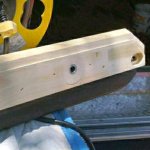With so many cheap made pool tables today, many of them make the rails 1 1/2" thick, using a bottom plate and top, finish plate. In between those two 3/4" plates the manufacturer inserts the rail bolt anchor T-nuts as a way of anchoring the rails down to the slate or cabinet frame.
What do you do when you come up on a table with the T-nut anchor spun out, bolt broken off, cut off, or otherwise unusable. Do you fix it, pass on it, drill another hole on the slate and anchor the rail down with a lag bolt, what do you do to make the repairs needed? Do you even bother with it?
What do you do when you come up on a table with the T-nut anchor spun out, bolt broken off, cut off, or otherwise unusable. Do you fix it, pass on it, drill another hole on the slate and anchor the rail down with a lag bolt, what do you do to make the repairs needed? Do you even bother with it?
